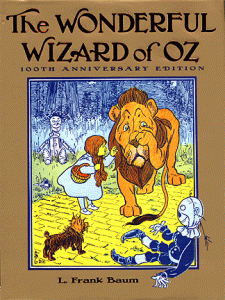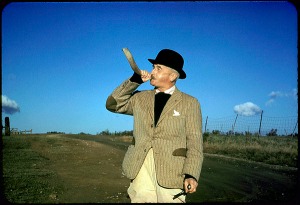Okay, enough of the doom and gloom! I decided to give my mommy brain a vacation and picked up an audiobook of The Wonderful Wizard of Oz. I don’t see how anyone could feel unhappy while listening to this story, which is why I want to buy a copy for my son. I’ve watched the movie dozens of times, but I’ve never read the book until now. For the most part, the movie follows the book pretty closely, but the movie script actually improves a few plot points.
The first thing that caught my attention was how Baum describes everything in Kansas as being gray and gloomy and then when Dorothy arrives in Munchkin Land it is full of all colors of the rainbow. This reminded me of how brilliantly the film goes from black and white to Technicolor. It’s an amazing movie moment. I couldn’t believe how similar the book and the movie were in that scene.
One memorable difference is that Book Dorothy is given silver shoes instead of ruby slippers. As the owner of both silver and ruby red ballet flats, I think either is a legitimate fashion statement. Silver is a great neutral and goes with everything, so Book Dorothy probably had more wardrobe options. But of course everyone remembers the sparkly red shoes from the movie, and probably every little girl (or gay boy) who watched Judy Garland trot down the Yellow Brick Road wanted to own heels just like them. If I’m not mistaken, the Smithsonian owns the real ruby slippers. So Dorothy had great and timeless style. In fact, in the book the silver shoes are the first thing that Oz asks Dorothy about when she arrives in the Emerald City. He sounds more like a fashions stylist than a wizard, but whatever. Moving on…
Did you know that Tin Woodsman, as he’s called in Baum’s book, once was engaged to a nice village girl until the Wicked Witch cursed him and turned him to metal? It’s such a sad little anecdote. The Tinman tells Dorothy that he promised to marry this girl once he made enough money from chopping wood to buy a house. And he thinks the poor girl is still waiting for him in her cabin where she lives with her mean aunt! I thought for sure at the end of the book he would dramatically reunite with this girl and have a big wedding in the forest. But, um, nope. The Tinman gets his heart and decides to rule some gang of midgets or something. So much for romance.
Another big difference between book and movie is that Book Oz and Book Wicked Witch aren’t too bright. Movie Wicked Witch is crazy scary and whip smart. In the book she tries to outsmart Dorothy and her pals by sending wolves and flying monkeys killer bees after them. The book goes all kinds of Hunger Games for a couple of chapters! But the witch seems really afraid of Dorothy and her silver shoes. In the end it’s death by bucket o water for her! Oz is a really crappy wizard, as he even admits himself. He tries to appear as a giant bald head, a pretty blonde girl, and a ball of fire to Dorothy and her friends. But then Toto exposes him for the fraud he is. And he really has no idea how to help them get courage, a heart, a brain and a trip to Kansas. He kind of throws together some arts and crafts (a courage energy drink for Cowardly Lion, a silk heart for Tinman, a set of pins for Scarecrow’s head, and a hot air balloon for Dorothy) and everyone seems satisfied. But then he takes off in the balloon without Dorothy like a chump! He really is useless. So the lesson here is that they all possessed the traits they wished for all along. Scarecrow was smart, the Lion was courageous, and the Tinman had a loving heart. And Glenda the super pretty Ginger Witch tells D in the end that she just has to click her heels together to get home. It’s all about the shoes, ladies!!!
But Victor Fleming did a great job condensing some repetitive scenes. In the book there are two or three trips to the Emerald City and more than one Good Witch who helps the kids and at least three road trips on the Yellow Brick. And the end of the book finds Dorothy at home in Kansas with her aunt and uncle, but it wasn’t all a dream like it was in the movie. I always loved the end of the movie where you see that the helpers on the farm were really the Scarecrow, Lion and Tinman. “And you were there and you were there and you were there!” That is movie magic. As a kid it made me believe that anything was possible, and that’s what good fairy tales should do.



